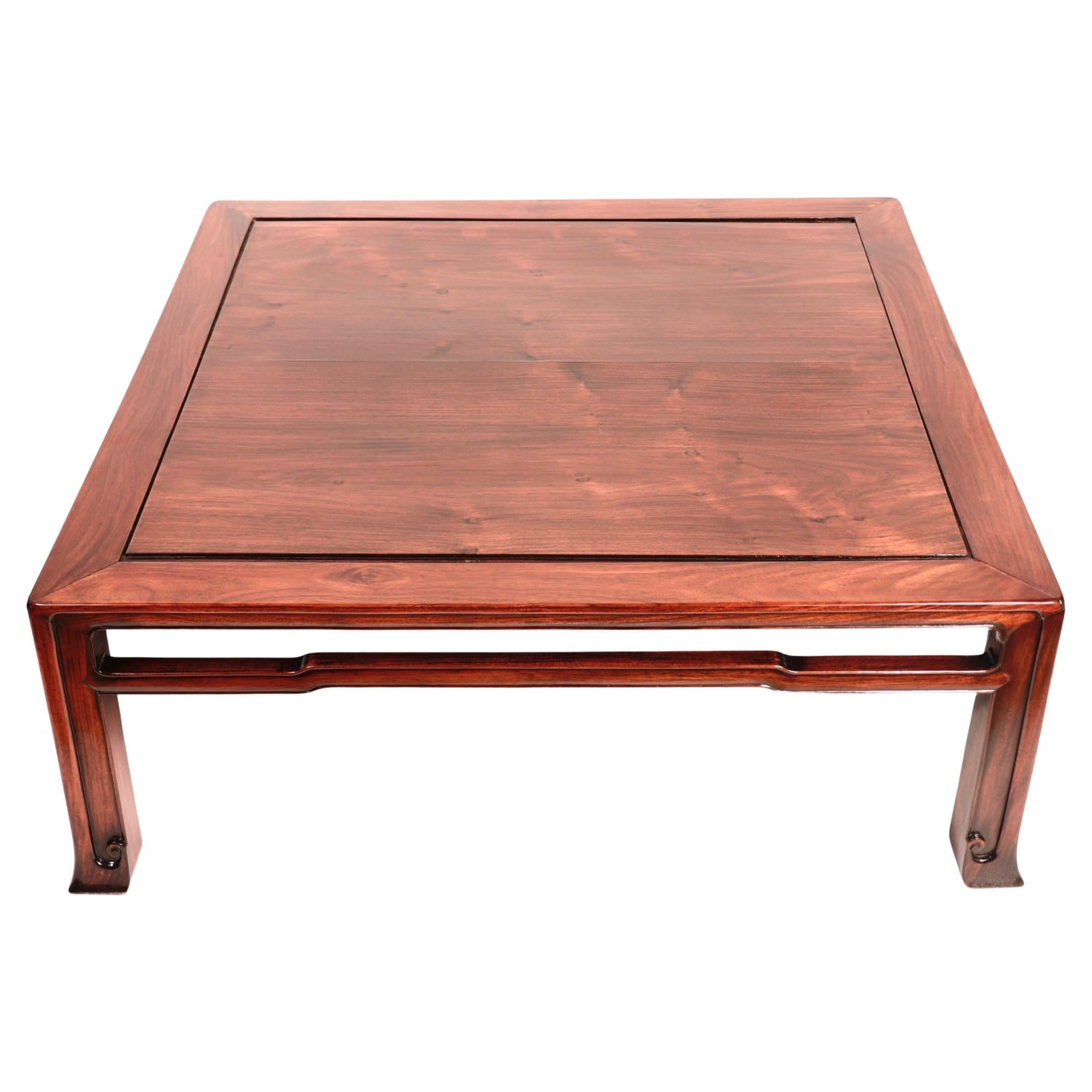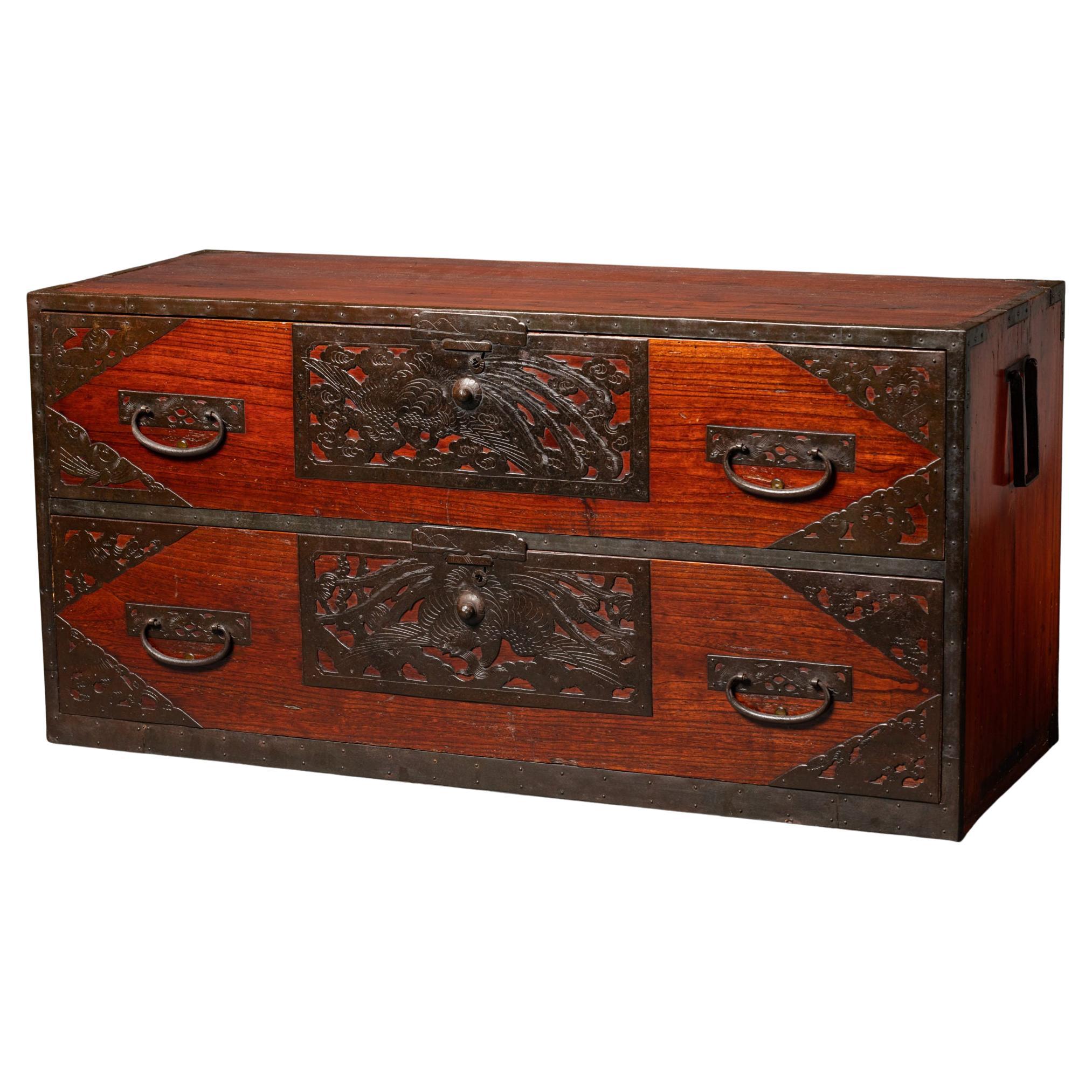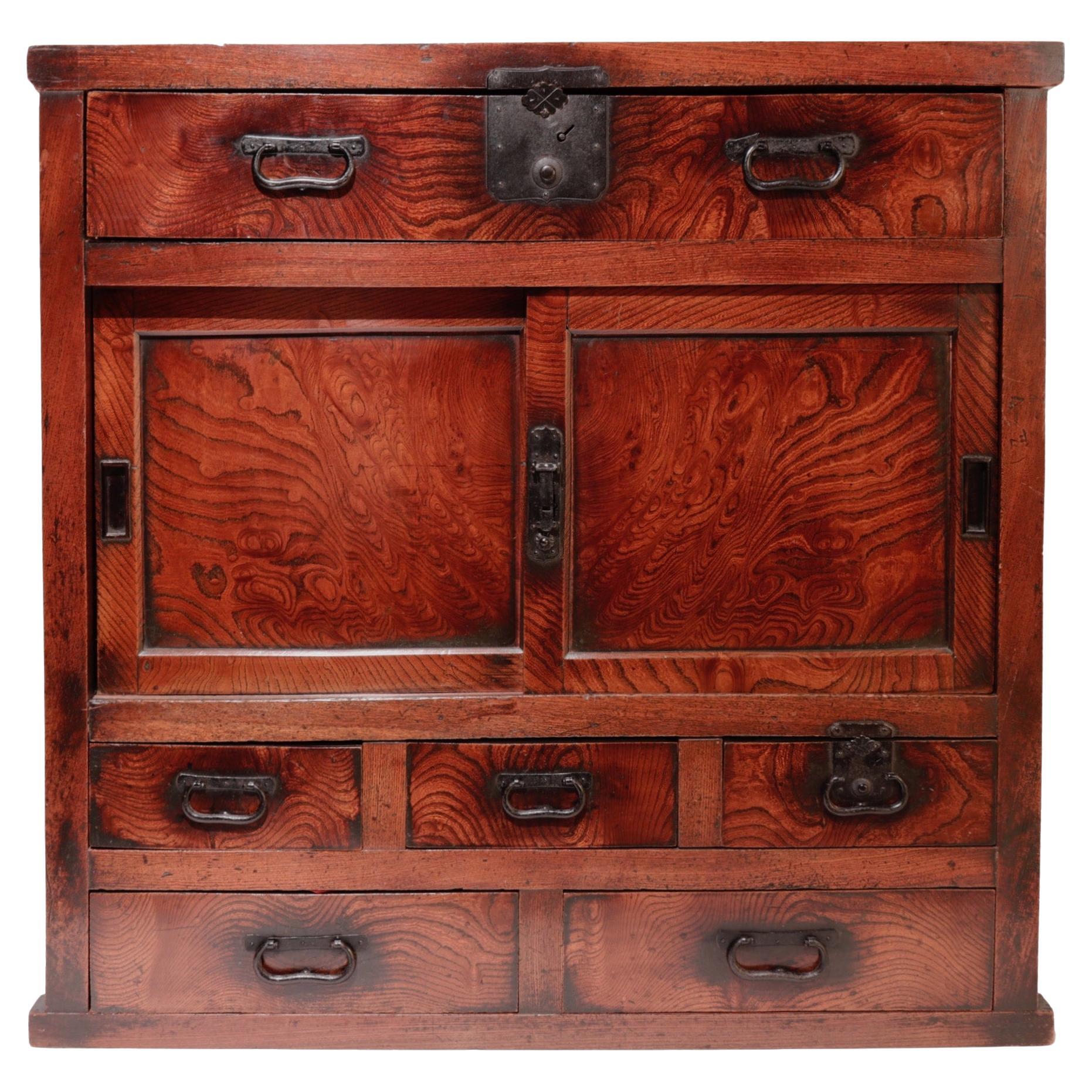Items Similar to Japanese American Cypresswood or Hirohi ‘Walsh, Hall & Co, Yokohama’ Tea Chest
Want more images or videos?
Request additional images or videos from the seller
1 of 5
Japanese American Cypresswood or Hirohi ‘Walsh, Hall & Co, Yokohama’ Tea Chest
About the Item
A Japanese Cypresswood or hirohi ‘Walsh, Hall & Co, Yokohama’ tea chest
Yokohama, 1862-1897, with inscription reading: Choicest Natural Leaf Yamashiro Tea, Packed by Walsh, Hall & Co, Yokohama
Measures: H. 53.5 x W. 61.5 x D. 41.5 cm
Including original wood box
The chest gold, silver and red lacquered on a black lacquer ground, the top decorated with an eagle sitting on a branch, looking at a small escaping bird, the front with a pheasant under a chestnut, one side with a cockerel amongst foliage, the back decorated with an argus pheasant-like bird amongst foliage. Walsh, Hall & Co. was a very successful commission trading-house in Yokohama, known as Ami-ichi (American No. 1), the first American firm to reach Yokohama in 1859. The firm was established by John Greer Walsh, and Thomas Walsh, joined by Francis (or Frank) Hall in 1861, and traded mainly in tea and silk. A colour woodblock-print by Hiroshige II (1826-1869) dating from circa 1861 titled Yokohama ijinkan no zu, shows an exceptionally faithful visual record of the Walsh, Hall & Company’s compound located at lot number two on the Bund, the Westerner’s term for the embankment along the harbour’s edge. The company’s early arrival in Yokohama secured its highly desirable location near the customhouse and one of the two stone piers. Under Frank Hall’s leadership, the business flourished. Hall, the sixth son in a family of sixteen children was born in Ellington Connecticut in 1822.
Hall graduated in 1838 from the Ellington School, founded in 1829 by his father, John Hall (1783-1847), a Yale graduate. The financial panic of 1837 made it impossible for him to attend Yale, so he took up a career as a teacher but soon gave up and moved to Elmira, New York, wherewith some financial help of two of his brothers, he opened the town’s first bookstore. Hall became a successful book dealer and his shop became the meeting place for local intellectuals and writers. In 1846 he married Sarah Covell, but unfortunately, she died rather quickly in 1848. Troubled by his wife’s death, Hall thought of leaving Elmira, but could not find a buyer for his bookstore. Finally, in. 1859 he sold his store to two of his brothers and decided to join three Dutch Reformed Missionaries on a trip to Japan as a correspondent for Horace Greely’s Tribune. Probably through mediation by Bayard Taylor, a friend of Frank Hall and America’s premier travel writer, who had gone to Japan with the Perry expedition in 1854 and had covered it for the Tribune.
Hall took up residence in Kanagawa in 1859, among a mere handful of Westerners then residing in the new Treaty Port. The seven years Hall was to be in Japan covered the most momentous period, during which the old feudal Shogunate gave way to the Meiji Restoration. Hall quickly learned Japanese and consequently not only recorded the daily life of Westerners in the treaty port in great detail but also much of the life of the Japanese around him. He published nearly seventy articles in the Tribune and kept a detailed journal that has become a major source on life in Japan during the mid-19th century. In addition, Hall was a keen photographer and serious student of Japanese plants and a friend to other ‘plant hunters’ including Philipp Franz von Siebold, George R. Hall and Robert Fortune. Unfortunately, his collection of photographs taken in Japan has yet to be rediscovered.
In 1861 Hall’s business instincts convinced him to bring some of his capital from the United States and to join the Walsh brothers in Walsh, Hall & Co. in Yokohama. In the print by Hiroshige II showing the Walsh Hall & Co. Garden in Yokohama, a shipment of George R. Hall’s plants going to the U.S. is shown. In 1866 Frank Hall returned to the United States but the firm continued under the name Walsh Hall & Co. in Yokohama until 1897 when, after the death of John Greer Walsh, the remaining interests were sold to the Mitsubishi Corporation. In 1872 Frank Hall was instrumental in sending Iwasaki Yanosuke, the man who came to head the Mitsubishi Corporation, to the exclusive (taking no more than twelve students annually) Hall Family School for Boys of his older brother Edward. After his return to Elmira, Frank Hall became a major philanthropist supporting Elmira College, the Steele Memorial Library, the Arnot-Ogden Hospital and other charities in Elmira. In 1902 he set out to build the Hall Memorial Library in Ellington Connecticut to honour the educational work of his father and brother Edward. When it was completed in 1903, the New York Tribune called it “one of the finest gifts ever made to a Connecticut town.’’ Hall also was a world traveller, for at the time of his death on August 26, 1902, the Elmira paper noted in his obituary, that “next to Bayard Taylor, he was the greatest American traveller, Greenland and Iceland being the only two countries he had not visited”. Hall’s massive and remarkable journal was only published in 1992 (F.G. Notehelfer, Japan through American Eyes: The Journal of Francis Hall, Kanagawa and Yokohama, 1859-1866. Princeton University Press).
The Walsh brothers had originally gone to China. John Greer Walsh came to Nagasaki in 1859 where he served as American Consul until mid-1860s. Walsh and Co’s agent in Kanawaga-Yokohama was the plant-hunter George R. Hall, who had been a doctor in China and came to Yokohama to trade in 1859 when the Harris Treaty first opened the port. It was George Hall (not related to Francis Hall) who insisted on Yokohama as the site for Walsh &
Co and selected the plot of land, No. 2 on the Bund. Dr. Hall’s name was not on the firm because he did not invest his money in it. When Francis Hall joined the Walsh Brothers as a full partner with his own capital in 1862, the firm was renamed “Walsh, Hall & Co. For a discussion of the Walsh Brothers see Norman and Nancy Bertram Beecher, Fortunate Journey, Concord, Mass, Norman Beecher, 1993.
- Dimensions:Height: 20.87 in (53 cm)Width: 24.02 in (61 cm)Depth: 16.15 in (41 cm)
- Sold As:Set of 2
- Style:Meiji (Of the Period)
- Materials and Techniques:
- Place of Origin:
- Period:
- Date of Manufacture:1862-1897
- Condition:Wear consistent with age and use.
- Seller Location:Amsterdam, NL
- Reference Number:1stDibs: LU5458228513832
About the Seller
5.0
Vetted Seller
These experienced sellers undergo a comprehensive evaluation by our team of in-house experts.
Established in 1985
1stDibs seller since 2020
19 sales on 1stDibs
Typical response time: 3 hours
- ShippingRetrieving quote...Ships From: Amsterdam, Netherlands
- Return PolicyThis item cannot be returned.
More From This SellerView All
- Peranakan Djati Wood Miniature Bed for an Anak Ambar, a Miscarried FetusLocated in Amsterdam, NLA Peranakan djati wood miniature bed for an Anak Ambar, a miscarried fetus Indonesia, Peranakan Chinese, late 19th century Measures: H. 41 x L...Category
Antique Late 19th Century Indonesian Furniture
MaterialsWood
- Japanese Export Lacquer Mother-of-Pearl Secretaire for the American MarketLocated in Amsterdam, NLA rare Japanese export lacquered secretaire for the American market Circa 1800-1830, Colonial Overall densely decorated with flower sprays and landscapes, minutely inlaid with ...Category
Antique 1810s Japanese Edo Furniture
MaterialsMother-of-Pearl, Wood
- Portuguese-colonial Japanese Namban lacquer Vargueno Cabinet, circa 1600Located in Amsterdam, NLA Portuguese-colonial Japanese Namban lacquer vargueno cabinet Momoyama period, circa 1600 H. 43 x W. 64.5 x D. 36 cm Wood, black lacquered and deco...Category
Antique Early 1600s Japanese Antiquities
MaterialsGold, Brass
- A Dutch-colonial Sri Lankan coromandel wood miniature chest of drawersLocated in Amsterdam, NLA Dutch-colonial Sri Lankan coromandel wood miniature chest of drawers with silver mounts Sri Lanka, 18th century, circa 1750 H. 35 x W. 48 x D....Category
Antique 18th Century Sri Lankan Dutch Colonial Furniture
MaterialsSilver
- Sri Lankan Mãrã or East Indian Walnut ‘Burgomaster’ ChairLocated in Amsterdam, NLA Sri Lankan mãrã or East Indian walnut ‘Burgomaster’ chair Galle, early 19th century Measures: H. 81.5 x W. 74 cm / seat height 45.5 cm / seat di...Category
Antique Early 19th Century Sri Lankan Dutch Colonial Furniture
MaterialsHardwood, Rattan
- Rare Charming 17th Century Japanese Lacquer Cabinet with Gilt-Bronze MountsLocated in Amsterdam, NLA fine Japanese pictoral style lacquer cabinet with gilt-metal mounts Kyoto, Edo period, 1670-1690 Decorated in Japanese relief lacquer work, black lacquer ground decorated...Category
Antique Late 17th Century Japanese Furniture
MaterialsBronze
You May Also Like
- Japanese Rosewood Square Tea TableLocated in Point Richmond, CAJapanese Rosewood Square Tea Table in Chinese style having tapered legs with bracket hoof feet, elbowed cross struts and center floating panel. Minor shrinkage, surface scratches, an...Category
Antique Early 1900s Japanese Meiji Furniture
MaterialsRosewood
- Japanese Meiji Period Elm and Iron Bound Table Tansu or Sea ChestLocated in San Francisco, CAA Japanese Meiji period iron mounted sea chest or table cabinet, the removable front cover opening to reveal an interior with 5 drawers of varying sizes. The piece is mounted with de...Category
Antique Mid-19th Century Japanese Meiji Furniture
MaterialsIron
- Japanese Tansu, chest-on-chest (isho kasane-dansu), YonezawaLocated in Point Richmond, CAJapanese chest-on-chest for clothing storage (isho kasane-dansu) from Yonezawa, constructed of hinoki (Chaemaecyparis obtusa) and keyaki (Zelkova serrata) drawer fronts, traditional ...Category
Antique Late 19th Century Japanese Meiji Furniture
MaterialsWood
- Japanese ChestLocated in Hudson, NYWith two drawers. Top section of a two section chest. Elaborate hardware with cranes and clouds design. Hardware on all corners.Category
Early 20th Century Japanese Furniture
MaterialsMetal
- Japanese Merchant’s chest (choba-dansu), ToyamaLocated in Point Richmond, CAJapanese Merchant’s chest (choba-dansu), Toyama, the front entirely constructed of keyaki (Zelkova serrata), original fuki-urushi lacquer fini...Category
Antique Late 19th Century Japanese Meiji Furniture
MaterialsHardwood
- Fine Japanese Portable Tea Cabinet Meiji Period with ProvenanceLocated in Atlanta, GAAn antique Japanese portable cabinet finely fashioned out of Sandalwood, a fragrant and also one of the most expensive woods that was used to make small luxury pieces. The handled ca...Category
Early 20th Century Japanese Meiji Furniture
MaterialsWood, Sandalwood





